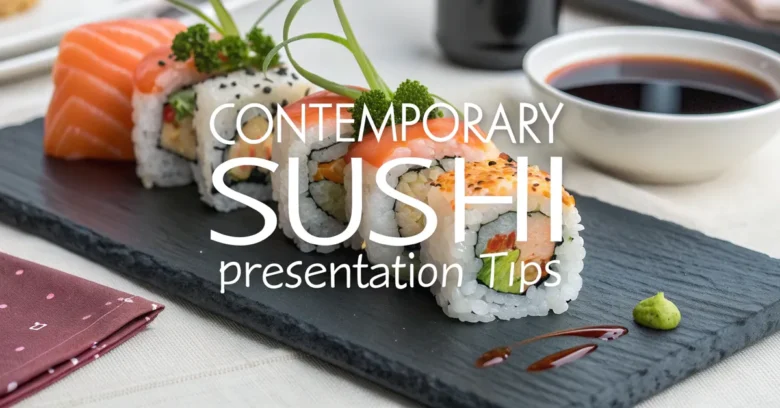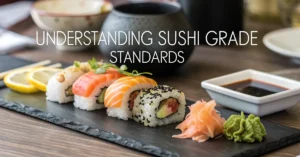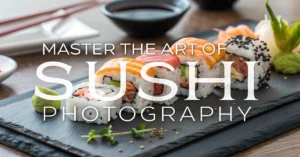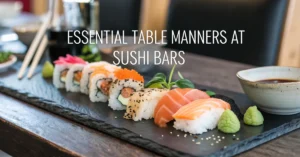Imagine you’ve crafted a delicious sushi roll, bursting with vibrant colors and fresh ingredients. But when you plate it, it looks… ordinary. Don’t let a lackluster presentation undermine your culinary efforts. Just like a painter needs a canvas, your sushi deserves a stage that showcases its beauty and artistry. You can turn a simple meal into a visual masterpiece that delights the senses with some modern presentation techniques.
Contemporary Sushi Presentation Tips
Sushi, often viewed as both a culinary art and a cultural icon, goes beyond mere taste. The art of sushi lies not only in the precise balance of flavors but also in the aesthetic appeal it presents to the diner. You can think of it as a food that feeds your eye. While traditional sushi presentation has its own charm, the modern era calls for innovation. Let’s dive into some ideas to elevate your sushi presentation.
Rethinking the Plate: Beyond the Traditional
The plate is your canvas. It’s the first element that sets the tone for the dining experience.
-
Embrace Minimalism: In modern presentation, less is often more. A clean, uncluttered plate allows the sushi to take center stage. Think of it as giving each piece room to breathe and be admired. Solid colors like matte black, slate gray, or stark white work wonders in creating a sophisticated backdrop.
-
Consider Unique Shapes and Materials: Break free from the confines of round, white plates. Explore rectangular platters, square plates, or even natural materials like slate or wood. These options add visual interest and a touch of rustic charm. Slate plates, for instance, offer a cool, dark contrast to the bright colors of sushi.
-
Play with Height: Level up the presentation by incorporating stands, risers, or small platforms. Lifting certain sushi pieces adds dimension and creates visual hierarchy. A small wooden block beneath a key sushi roll, for example, will draw the eye and highlight its importance.
The Art of Arrangement: Composing Your Sushi Symphony
The arrangement of your sushi on the plate is just as important as the plate itself.
-
Follow the Rule of Odds: Design principles are essential here. An odd number of sushi pieces, such as three, five, or seven, often creates a more visually appealing composition than an even number. This trick taps into our natural tendency to seek balance, but with a hint of asymmetry that keeps things interesting.
-
Create Flow and Movement: Arrange the sushi pieces in a way that guides the eye across the plate. A gentle curve, a diagonal line, or a spiraling pattern can add a sense of movement and dynamism. This way, the plate will keep your guest looking.
-
Group by Type or Color: Create visual harmony by grouping similar sushi pieces together. This could be by type of fish, style of roll, or color palette. For example, arrange all the salmon nigiri in one section and the tuna nigiri in another, creating distinct visual zones on the plate.
-
Leave White Space: Don’t overcrowd the plate. Leaving empty space around the sushi pieces allows them to stand out and prevents the presentation from looking cluttered. Think of it as the silence between musical notes, equally important for the overall impact.
Garnishes and Accents: The Finishing Touches
Garnishes are like the jewelry that adorns your sushi. Use them sparingly and thoughtfully to enhance the overall presentation.
-
Edible Flowers: Delicate and vibrant, edible flowers add a touch of elegance and whimsy to your sushi plate. Choose flowers that complement the colors of the sushi, such as purple pansies with yellow accents, or bright orange nasturtiums.
-
Microgreens: These tiny greens pack a big punch of flavor and visual appeal. Sprinkle them around the sushi pieces or use them to create a small mound in the center of the plate. Microgreens come in a variety of colors and textures, allowing you to add both visual and gustatory complexity.
-
Seaweed Salad: A small mound of vibrant green seaweed salad adds a refreshing element and a pop of color to the plate. Choose a high-quality seaweed salad with a bright, clean flavor that complements the sushi.
-
Ginger and Wasabi: These traditional accompaniments can also be used as decorative elements. Instead of simply placing them on the side, try arranging them in a small, artistic swirl or dot.
-
Sauce Drizzles: A delicate drizzle of soy sauce, spicy mayo, or eel sauce can add visual interest and enhance the flavors of the sushi. Use a squeeze bottle or a fine-tipped spoon to create precise lines or patterns.
Sauce Presentation: A Symphony of Flavors and Visuals
Sauce presentation is crucial to the overall appeal of your sushi creation. Let’s explore ways to showcase your sauces with flair:
-
Strategic Placement: Rather than simply pouring sauce over your sushi, consider placing small dollops or strategically drizzling it to highlight specific flavors. This allows diners to experience the sauce in harmony with the sushi, rather than overpowering it.
-
Contrast and Harmony: Experiment with sauces that offer both visual contrast and flavor harmony. For example, a vibrant green wasabi aioli alongside a rich, dark eel sauce can create a visually striking and palatable experience.
-
Edible Art: Use sauces as your artistic medium. Create swirls, dots, or even miniature abstract patterns on the plate to complement the sushi arrangement. This not only enhances visual appeal but also adds an element of surprise and sophistication to the dish.
Plating for Different Sushi Types: Tailoring the Presentation
Each type of sushi has its own unique characteristics, so the presentation should be tailored accordingly.
-
Nigiri: This simple yet elegant form of sushi, consisting of sliced fish atop a bed of rice, benefits from a minimalist approach. Arrange the nigiri pieces in a neat row or a gentle curve, allowing the quality of the fish to shine through. A small dab of wasabi and a single sprig of microgreens can provide the perfect finishing touch.
-
Sashimi: With its focus on pristine slices of raw fish, sashimi demands a presentation that emphasizes freshness and quality. Arrange the slices in a fan-like pattern or a staggered row, highlighting the color and texture of each piece. Consider adding a bed of shaved daikon radish or a few shiso leaves for visual and aromatic appeal.
-
Maki Rolls: These rolled sushi variations offer more opportunities for creative presentation. Stand the rolls on end to showcase their vibrant fillings, or arrange them in a circular pattern to create a sense of movement. A drizzle of sauce or a sprinkling of sesame seeds can add visual interest.
Color Theory: Painting with Sushi
Color plays a vital role in the appeal of your sushi. By understanding color theory, you can create visually stunning plates that stimulate the appetite.
-
Complementary Colors: Use complementary colors, such as red and green or yellow and purple, to create bold contrasts that draw the eye. For example, arrange slices of ruby-red tuna alongside emerald-green avocado for a striking visual effect.
-
Analogous Colors: Analogous colors, which are adjacent to each other on the color wheel, create a harmonious and soothing visual experience. For instance, combine slices of salmon (orange) with slivers of yellowtail (yellow-orange) and a sprig of tangerine-colored microgreens.
-
Monochromatic Palettes: Create a sense of elegance and sophistication by using a monochromatic color scheme. For example, arrange different shades of pink, from the pale blush of shrimp to the deep rose of tuna, for a visually refined presentation.
Lighting and Photography: Capturing the Essence
In the age of social media, the presentation doesn’t end with the plating. Capturing a stunning photo of your sushi is essential for sharing your culinary artistry.
-
Natural Light is Key: Whenever possible, photograph your sushi in natural light. Soft, diffused light will bring out the colors and textures of the sushi without creating harsh shadows.
-
Pay Attention to Composition: Use the rule of thirds to create a balanced and visually appealing composition. Position the sushi off-center, allowing for negative space and visual flow.
-
Experiment with Angles: Try different angles to find the most flattering perspective. A close-up shot can highlight the details of the sushi, while a wider shot can showcase the entire plating.
Garnishing Techniques for Social Media Appeal: The Reel Deal
With social media shaping food trends, you have to consider how your sushi looks on a screen.
-
Dynamic Garnishes: Use garnishes that have movement or texture that translates well on video. Think of a gentle cascade of microgreens or a sauce drizzle that seems to dance across the screen.
-
Color Pops: Bright, bold colors are eye-catching and perform well on platforms like Instagram and TikTok. Incorporate colorful ingredients like edible flowers, vibrant seaweed salads, or vividly hued sauces.
-
Interactive Elements: Consider adding elements that invite interaction, such as a small dish of spicy mayo for dipping or a sprinkle of sesame seeds that diners can add themselves. These create engagement opportunities and make your sushi more shareable.
Sustainable Presentation: Eco-Conscious Choices
In today’s world, sustainability is more than just a trend; it’s a responsibility. You can showcase your commitment to the environment with your sushi presentation.
-
Eco-Friendly Plates: Opt for plates made from sustainable materials like bamboo, reclaimed wood, or biodegradable plastics. These options not only look stylish but also reduce your environmental footprint.
-
Reusable Garnishes: Instead of single-use garnishes, consider using reusable options like small, washable stones or edible flowers that can be regrown.
-
Minimize Waste: Be mindful of portion sizes and avoid over-garnishing. Only use what is necessary to enhance the presentation and flavor of the sushi, minimizing food waste.
Advanced Techniques: Pushing the Boundaries
For those looking to truly elevate their sushi presentation, here are some advanced techniques to consider:
-
Dry Ice Effects: Add a touch of drama and intrigue with dry ice. Place a small piece of dry ice beneath the sushi or in a separate container to create a swirling mist that envelops the dish.
-
Edible Art: Use edible paints, powders, or gels to create intricate designs directly on the sushi or the plate. This allows you to add a personal touch and showcase your artistic skills.
-
Deconstructed Sushi: Instead of presenting the sushi in its traditional form, deconstruct the elements and arrange them in a creative and unexpected way. This allows diners to appreciate each ingredient individually while still experiencing the flavors of the sushi as a whole.
Mastering the Art of Balance: Harmony in Every Detail
A successful sushi presentation goes beyond mere aesthetics; it’s about achieving balance in every aspect of the dish.
-
Visual Equilibrium: Ensure that the presentation is visually balanced, with no single element overpowering the others. This can be achieved by distributing colors, textures, and shapes evenly across the plate.
-
Flavor Harmony: The presentation should complement the flavors of the sushi, not detract from them. Choose garnishes and sauces that enhance the taste and aroma of the fish and rice.
-
Cultural Respect: While modern presentation encourages creativity, it’s important to respect the traditions and cultural significance of sushi. Avoid using techniques or ingredients that are disrespectful or inappropriate.
Staying Updated with Trends: The Ever-Evolving World of Sushi
The world of sushi presentation is constantly evolving, with new trends and techniques emerging all the time. Stay on top of the latest developments by:
-
Following Sushi Chefs on Social Media: Platforms like Instagram and TikTok are great sources of inspiration. Look for chefs who are pushing the boundaries of sushi presentation and experimenting with new techniques.
-
Reading Food Magazines and Blogs: Keep an eye on food publications for articles and features on sushi presentation. These resources can provide valuable insights into current trends and emerging styles.
-
Attending Sushi Workshops and Demonstrations: Hands-on learning is one of the best ways to improve your sushi presentation skills. Look for workshops and demonstrations led by experienced sushi chefs.
Common Mistakes to Avoid: Pitfalls in Presentation
While the path to perfect sushi plating is filled with creative license, it’s good to be aware of common pitfalls that can sabotage your efforts. Steer clear of these blunders to ensure a polished final product:
-
Overcrowding the Plate: A cluttered plate overwhelms the eye and detracts from the beauty of the sushi itself. Less is more—allow your sushi to breathe.
-
Using Mismatched Plates: The plate should complement the sushi, not clash with it. Avoid overly busy patterns or colors that compete with the vibrant hues of the dish.
-
Ignoring Textural Balance: A plate full of uniformly smooth sushi can be visually boring. Incorporate textural contrasts with garnishes like crispy tempura flakes or crunchy seaweed salad.
-
Forgetting About Functionality: Pretty sushi is pointless if it’s impractical to eat. Make sure your arrangements allow for easy access and clean consumption.
The Power of Personalization: Reflecting Your Style
Ultimately, the best sushi presentation is one that reflects your personal style and culinary vision.
-
Experiment with Different Techniques: Don’t be afraid to try new things and experiment with different plating styles. The more you practice, the better you’ll become at creating visually stunning sushi presentations.
-
Draw Inspiration from Other Sources: Look to art, nature, and other cuisines for inspiration. The possibilities are endless.
-
Have Fun and Be Creative: Sushi presentation should be a fun and rewarding experience. Let your creativity flow and enjoy the process of transforming simple ingredients into a work of art.
Should You Focus on Modern Sushi Presentation?
The art of sushi presentation is an ongoing journey of discovery and refinement. Take risks and break the rules. Keep honing your skills to find the most beautiful and delicious way to showcase your sushi creations. It will enhance the dining experience for your patrons, friends and family.



